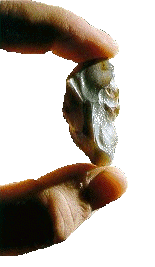
ISERNIA'S "LA PINETA"
Text of Carl Peretto
Translation by Hugo del Gesso

|
LITHIC INDUSTRIES AT ISERNIA'S "LA PINETA" Text of Carl Peretto Translation by Hugo del Gesso |
These findings have been collected during regular excavations started
in 1979 and still in process. The methods come from two distinct
locations, one situated in the northern part (section 1), the other in the
southern part (section 2) in the elevated buffer- portion of
Isernia-Rome railroad bed, only distant a couple of hundreds meters
between them. The articles are made up of FLINTSTONE
and LIMESTONE, the
latter only found in section 1. The lithic material used for the
splitting process is still found today around La Pineta area. Thus, is
very probable that the prehistoric man would find nearby materials
needed for the manufacturing of his tools. The characteristics thus, are
found in the slag of the dorsal part of some reperts deducting that the
lithic materials used were those of flint and limestone rocks, the latter
or very small dimensions. At times it has been witnessed the usage of
"natural" fragments as well.

|
SYMBOLIC SPECIFICATIONS The tools are made up with a summary indentation. The separation can be isolated or in a sequence, thus creating a milled border. Very seldom this border is of the dented type, as matter of facts it has been obtained with single and deep cuts. For this reason is not obtainable with small pieces. The work with this type of touch-ups is rare as opposite to other procedures. Often the touch-up is used to modify the original structure of the splinter otherwise impossible using classic guidelines. 90% of items manufactured in this way are by far the ones most often found.
|

|

|

|

|

|
Copyright © 1997-2000 Arch. Davide Monaco - Isernia - ITALY